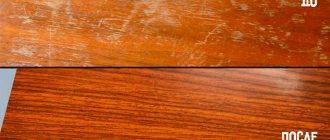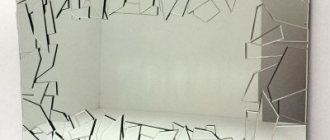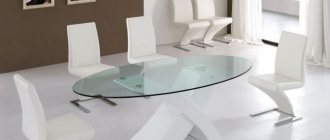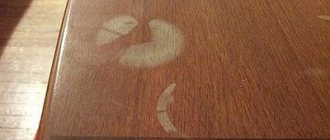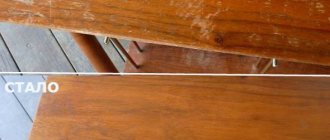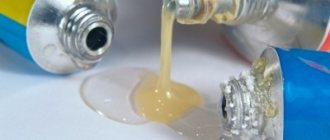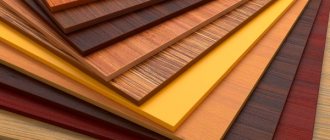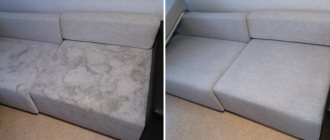Mechanical damage - scratches, abrasions - greatly deteriorate the appearance of the furniture. Even minor defects can ruin the aesthetics of interior items if they are on the front surface. Usually their cause is natural wear of wood or exposure to external factors.
There are different methods to remove scratches from furniture. Using inexpensive means, you can update products and save on buying new ones.
Scratches and abrasions on wooden furniture
Furniture wax: types and method of application - Instructions + Video
Wooden furniture can add coziness to any room; it is simultaneously beautiful, functional and durable, for which it is valued among buyers.
But during use, abrasions and scratches may appear on it, which spoil the appearance, while the other properties of the furniture are not lost and there is no point in replacing it. In order to get rid of the resulting defects, furniture wax is used. It is also worth noting that the scope of its application is somewhat wider than just furniture.
Why are scratches dangerous?
There are many reasons in everyday life that cause the formation of scratches. Deep and superficial, large and small, chips and dents, all of them negatively affect the condition of the furniture. And the point is not even a deterioration in appearance, but rather a reduction in the service life.
A scratch is damage to the surface layer, which quickly renders the furniture unusable. If we talk about inexpensive interior elements, the slightest damage to the protective layer provokes the release of harmful toxic substances into the air of the living space.
Moisture quickly penetrates into the recesses on the surface, lingers there and provokes a change in the strength and integrity of the furniture. Therefore, it is important to promptly remove all damage in order to preserve and increase the service life of the headset.
What is furniture wax used for?
- First of all, of course, it is used for furniture restoration. In addition to the fact that it effectively copes with chips and scratches, it also gives objects shine, makes their color more saturated, resulting in a renewal effect;
- For restoration of wooden floor coverings. When laminate or parquet wears out, you can refresh it using furniture wax, without resorting to paid services;
- Restoration of decorative items, which include picture frames, boxes or wooden figurines;
- Removing scratches and chips on window frames and wooden doors.
Before using furniture wax, you need to choose which type is suitable for a specific surface and type of damage.
General tips and tricks
Preventing scratches from occurring is much easier than dealing with them later. Deep damage further increases the risk of chips, which will render the furniture unusable.
What products do you use to remove scratches from furniture? Special helpers
Therefore, the following rules must be observed:
- Do not use sharp objects to clean heavily soiled furniture. For this purpose, soft abrasives are used that do not harm the surface.
- Check furniture for scratches and try to repair them as soon as they are found.
- If the damage is deep, it makes sense to turn to professionals who can preserve the integrity of the furniture and hide the defect as much as possible.
In conclusion, it is worth noting that not all remedies are effective the first time. Some require daily repetition. It is important to monitor and maintain your furniture, just like your own health. Incorrectly selected cleaning products, lack of protective mats and tablecloths can speed up the process of scratching.
Types of wax
Furniture wax is available in several types on the market:
- Soft. Used for minor scratches and damage, to update the appearance of furniture or wooden decorative items and give them additional shine. It is worth noting that this type of furniture wax is not suitable for use on items that are exposed to ultraviolet rays;
- Solid. Has the same functionality, but is more useful when you need to deal with deep scratches;
- Liquid wax is used for any damage; its advantage is that, due to its composition and consistency, it is able to flow and fill any cracks and damage.
ATTENTION! Liquid wax can be applied to horizontal and inclined surfaces, but not to vertical ones.
In order to learn how to use furniture wax, you need to read the instructions that come with each composition. You can also find out the composition there.
Replacing a damaged board
If the defect cannot be eliminated, the damaged element should be replaced. Find a board that is identical to the others in texture and shade. It is better to purchase exactly the same floor covering.
It is easier to replace if the damaged element is located close to the wall. Step-by-step algorithm:
- Use a screwdriver or pry bar to remove a piece of baseboard near the damaged area.
- Pry up the elements closest to the damaged board and carefully pull them out of the lock. It is important that the defective board is free on the left and front.
- Carefully remove the damaged board and place a new one in its place.
- Install adjacent boards, moving from right to left. The corner element should take its place last.
- Reinstall the baseboard.
- Check that the boards fit snugly against each other at the fastening points.
This method is suitable if the laminate is equipped with combination or twist locks. In this case, the work will require simple tools: a new block, a screwdriver or a pry bar.
If the damaged laminate board is located in the center of the room, it is easier to cut it out using a grinder. A new element must be installed into the resulting recess. To secure it thoroughly, use special glue.
Replacing scratched laminate boards
Important! Before installation, the new board must be kept for 1-3 days at room temperature.
Benefits of furniture wax
The use of such a product in the care of wooden objects is becoming increasingly popular at home.
This is due to its undeniable advantages, including:
- Lighting the color and giving it saturation;
- Getting rid of damage;
- A wide variety of color shades, allowing you to choose wax to match the color of your furniture;
- Water-repellent effect, which is given to an object after waxing;
- Protection against surface abrasion and rotting processes.
Preventing floor damage
To avoid having to think about how to restore laminate flooring, follow simple preventive measures. Useful tips:
- To prevent scratches from falling objects, place a rug or carpet over your laminate flooring. It is not necessary to cover the entire area of the room - it is enough to protect the central space. Try to choose an original carpet to match the style of the interior.
- Do not drag furniture or other heavy structures. If the process is unavoidable, first stick soft silicone pads on the legs of cabinets, sofas, tables and beds. They minimize the risk of damage to the coating.
- Try not to walk around rooms wearing high-heeled shoes. Almost always, after such fashion shows, micro-scratches remain on the laminate, which become more and more visible over time.
- Monitor your pets' behavior. Their sharp claws regularly damage laminate flooring, leaving it unattractive. If you have a cat, provide a scratching post. The pet will be busy and will not spoil the floor covering.
- Handle sharp and heavy objects more carefully. Try not to drop them on the floor. If this happens, immediately take measures to eliminate the defect.
If you've already scratched your laminate flooring, don't delay repairs. The longer you delay solving the problem, the less chance you have of getting your coverage restored.
Light laminate without scratches
How to apply furniture wax?
Regardless of what type of product is chosen, before applying to the surface, it must be prepared by wiping off dust. If the surface is varnished, you will need to remove the coating with a special furniture solvent.
Further, the application method differs depending on the type of product:
- To apply soft wax you will need a special spatula, a knife and a soft cleaning cloth. First, the required amount is collected on a spatula and applied to the damaged area, and the excess is carefully removed with a knife. Next, using a spatula, smooth the material in a circular motion. And at the end, polish with a soft cloth until the composition ceases to be noticeable and becomes homogeneous with the surface.
- To apply hard wax, you must first melt it using a soldering iron or lighter. The wax is heated to room temperature and then applied to the areas of chips or cracks and smoothed out.
If necessary, after application the surface is also polished with a cloth.
You can buy furniture wax in construction stores or hypermarkets, for example, in Leroy Merlin. Most often you can find soft wax on sale, but hard wax is a little more difficult to find and the price will be higher.
Leather furniture and scratches: the best remedies
Scratches from pets and the use of sharp objects can cause serious damage. And while small and shallow cuts can still be dealt with, complete damage to the leather fabric dictates the need to apply a decorative patch or replace the entire section of furniture.
Banana peel Olive oil
Banana peels and olive oil help mask scratches on light-colored furniture. Apply a few drops of vegetable fat to the inside of the skin and treat the damage with soft circular movements. Leave until completely absorbed, then polish with a dry soft cloth.
Strong black tea and coffee will help scratches on a black and brown sofa. They are brewed in equal proportions, after which they are applied to the damaged areas with a thin brush. Excess moisture must be removed.
Markers have proven themselves well; they not only help to even out the color and make the scratch invisible, but also fill in its structure.
Reviews of wax pencil
Wax pencil has a wide color spectrum. However, it is important to choose a shade that matches the color of the surface of the damaged piece of furniture. If this was not possible, then you can get the shade yourself. To do this, consumers are advised to purchase wax pencils in dark and light shades, taking into account the colors of the furniture or wooden surfaces that will be worked on.
Next, take a metal spoon, heat it, and then place the shavings of wax pencils on the surface. As soon as it melts, the mass should be stirred and wait until it cools. Consumers are advised to use this technology to select the desired proportion so that the color matches as closely as possible the shade of the furniture that needs to be restored.
Wax pencil for laminate is used in general according to the same principle as described above. It is suitable for repairing minor damage. The main advantage of this tool is ease of use. The mixture is environmentally friendly, because the ingredients do not contain harmful substances. To carry out the work you will need:
- dry and wet rags;
- wax pencil for laminate;
- vacuum cleaner.
You should not go to the store without taking a sample of the flooring with you, because you will not be able to choose the right shade. Once you have managed to buy a pencil, you can begin to process the surface; to do this, it is cleaned of dust, grease, debris and other contaminants. The base is left to dry, only then can you begin applying the pencil.
As soon as the damaged area is hidden, you need to leave it for a few minutes, and then you can start polishing the treated surface with a dry cloth. This will remove excess wax. After about an hour, you will be able to use the restored surface without noticing that there was ever any damage there.
Wax pencils for furniture can also be used for floor coverings when the surfaces have cracks, scratches, abrasions, chips and damaged corners, as well as edges. Consumers emphasize that unraveling seams on laminated surfaces, chipboard and plastic can be successfully decorated with this material.
There are no oily substances in the composition, so the ingredients, according to consumers, are well compatible with paint coatings on different bases. For more convenient application, home craftsmen advise using a plastic spatula, removing excess product from the surface using the same tool.
DIY laminate restoration
The main causes of damage to laminate floors:
- poor-quality installation of lamellas;
- mechanical impacts from shoes;
- contact with sharp edges of objects;
- moving across the surface without backing of massive furniture;
- falling of heavy objects;
- spillage of aggressive or polluting liquids;
- plumbing or heating accidents;
- careless handling of fire.
Dents in the flooring
All defects can be divided into 3 groups:
- Minor damage and abrasions;
- Deep scratches, dents;
- Deformation or destruction of lamellas.
Eliminating the latter defects is more difficult, as it requires disassembling the coating and possessing certain knowledge and skills. In such cases, you cannot do without inviting specialists. Small abrasions can be easily removed using masking agents.
More often, mechanical stress deforms or destroys the outer layers of the laminate. On top there is a transparent protective film made of melamine or acrylic resin, just below there is a decorative layer that imitates wood or other materials and consists of processed cellulose or furniture foil.
The task of restoration is to select a masking material that will hide the damage and protect against the penetration of moisture and dirt. Of course, it is impossible to completely remove a scratch in this way, but you can achieve a visual effect.
Instructions for use
Before you begin work on restoring the surface and eliminating scratches and chips, you need to prepare a wax pencil and sandpaper. Before restorative manipulations, the surface must be sanded. If you notice that peeling particles have formed on the base, they should be cut off using a blade. Ultimately, you should achieve a well-cleaned material.
A furniture pencil is applied to the surface. It contains:
If the wax pencil needs to be melted, then you should not expose it to direct flame, because it will simply catch fire. This can be done using any metal object that is preheated over a flame. And to apply a pencil to the surface, you need to use a knife with a thin blade, the tip of which should be heated over a flame.
The pencil is melted with a knife, and then part of it is applied to the damaged area. You should try to fill the chip or crack until the wax is slightly above the base. Now the surface should be left until the wax cools.
How to remove scratches from a glass table using different technologies
Glass is much stronger and more resistant to external influences compared to wood. However, scratches also form on such surfaces. To eliminate them use:
- specialized kits for restoring car glass;
- clear nail polish;
- toothpaste.
The last resort will require considerable effort. It is used for surface grinding followed by washing.
It is much more effective to use GOI paste
This tool was created in the early 30s of the last century. Despite its considerable age, its consumer parameters are highly valued by professionals and ordinary users. Polishing is done manually, without excessive effort.
For your information! A homemade paste can be made from baking soda and water.
Related article:
How to clean a washing machine with citric acid. Let's look at how to clean a washing machine with citric acid and other available products to increase the life expectancy of the equipment.
